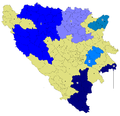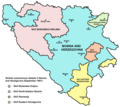Serb Autonomous Regions
From August 1990 to November 1991, during the
SAOs in Croatia
Second map: Serbs of Croatia per settlement in 1981 census
The so-called anti-bureaucratic revolution of Serbian leader Slobodan Milošević aimed at strengthening of Yugoslav federal institutions triggered condemnations and separatist response in Slovenia and Croatia. This in turn provoked security dilemma among at the time numerous Serbs of Croatia community which strongly opposed any move towards Croatian independence if it will separate them from the other parts of Yugoslavia. The dilemma was rooted in historical experience of the Genocide of Serbs in the Independent State of Croatia stirred up by rising Serb and Croat nationalism. Croatian Serb political leaders of the nationalist Serb Democratic Party advocated for the partition of Croatia in case of independence which would enable Serb inhabited areas to remain in Yugoslavia.
Croatian Serb politician Jovan Rašković argued for the creation of the "integral region" by bringing together predominantly Serb municipalities in Croatia into an Association of Municipalities which would act as one of the first-level administrative units within the republic.[4] While the Croatian legal system at the time formally permitted such a form of municipal organization the move was perceived as highly controversial and led to some of the first clashes.[4]
The first such association was formed around the town of
The process of creation of the self-proclaimed Serb Autonomous Regions in Croatia included inter-ethnic clashes and violence as well as widespread
SAOs in Bosnia and Herzegovina
The
- Autonomous Region of Krajina) in April 1991. It was the largest region, but after failure to merge with SAO Krajina in Croatia, it was renamed SAO Bosanska Krajinain September 1991.
- SAO Semberija i Majevicain December 1991.
- SAO Northern Bosnia, formed in November 1991, never fully controlled its proclaimed territory.
- SAO Ozren-Posavina, planned from predominantly Bosniak and Croat municipalities in northern Bosnia, but not fully established.
- SAO Romanija-Birač.
- SAO Herzegovina (also known as SAO Eastern Herzegovina), formed in September 1991.
-
SAOs in Bosnia and Herzegovina (Autumn 1991)
-
SAOs in Bosnia and Herzegovina (September 1991)
-
SAOs in Bosnia and Herzegovina (November 1991)
References
- ISBN 978-0-86356-367-6.
- ISBN 978-1-55753-617-4.
- ^ John Oppenheim; Willem-Jan van der Wolf; Global Law Association (2003). Global war crimes tribunal collection. Global Law Association.
- ^ Goldsmiths College. Retrieved 14 September 2019.
- Parliament of Croatia (3 June 1992). "Ustavni zakon o ljudskim pravima i slobodama i pravima etničkih i nacionalnih zajednica ili manjina u Republici Hrvatskoj". Narodne novine (in Croatian) (34/92). Zagreb. Archivedfrom the original on 20 January 2015. Retrieved 7 August 2012.
- Parliament of Croatia (21 September 1995). "Ustavni zakon o privremenom neprimjenjivanju pojedinih odredbi Ustavnog zakona o ljudskim pravima i slobodama i o pravima etničkih i nacionalnih zajednica ili manjina u Republici Hrvatskoj". Narodne novine (in Croatian) (68/95). Archivedfrom the original on 17 September 2014. Retrieved 7 August 2012.
- Parliament of Croatia (19 May 2000). "Ustavni zakon o izmjenama i dopunama Ustavnog zakona o ljudskim pravima i slobodama i o pravima etničkih i nacionalnih zajednica ili manjina u Republici Hrvatskoj". Narodne novine (in Croatian) (51/2000). Archivedfrom the original on 20 January 2015. Retrieved 7 August 2012.
- JSTOR 45371632.
- ISBN 978-1-84545-791-4.
Further reading
- Stefan Grubač (1993). Srpske teme, 1989-92. ZIZ. ISBN 978-86-81883-10-5.
- Dobrica Ćosić; Ana Ćosić-Vukić (2009). Srpsko pitanje u XX veku: lična istorija jednog doba. Службени гласник. ISBN 978-86-519-0371-0.
See also
- Self-determination
- Quasi-state
- Separatism
- Polish National Territorial Region
- Autonomous Province of Western Bosnia
- Autonomous Administration of North and East Syria
- Wa State





